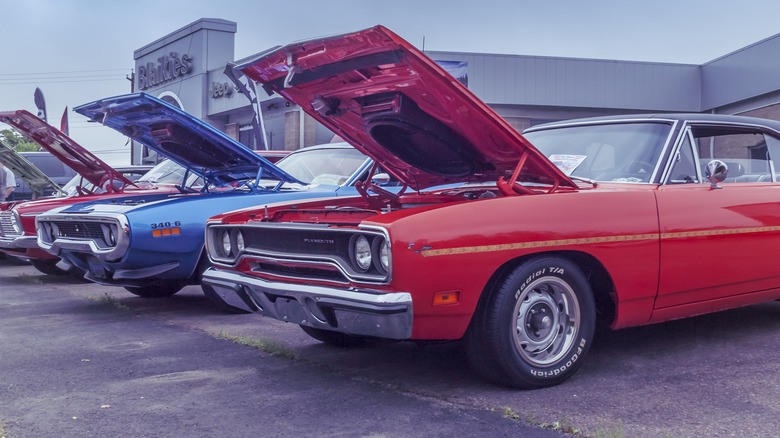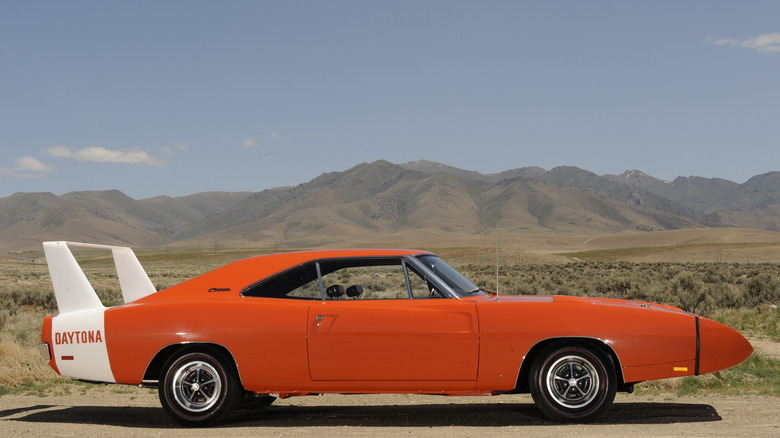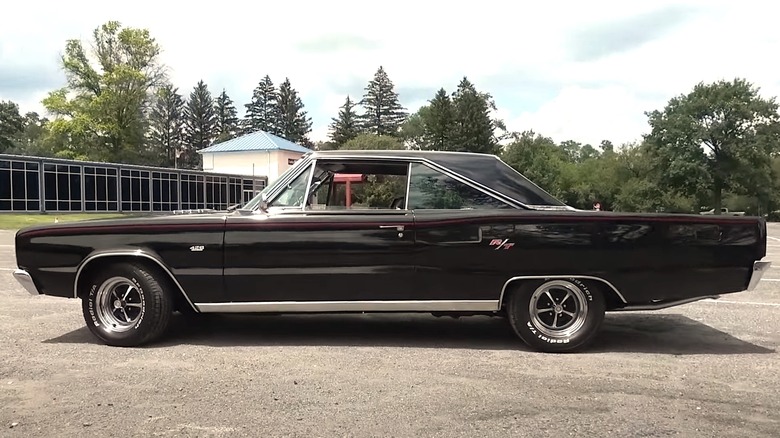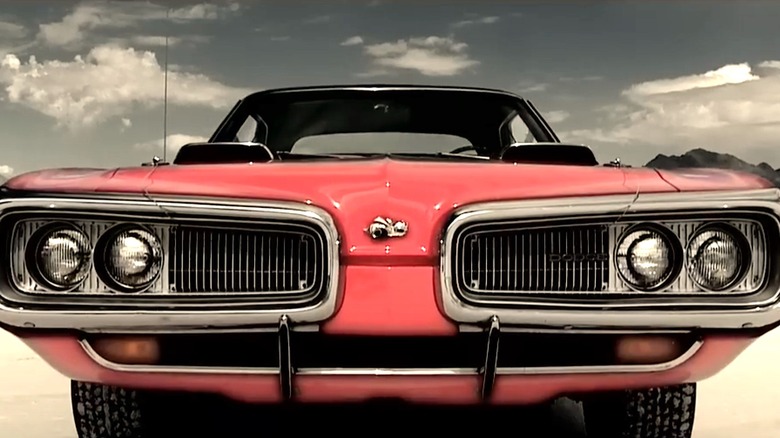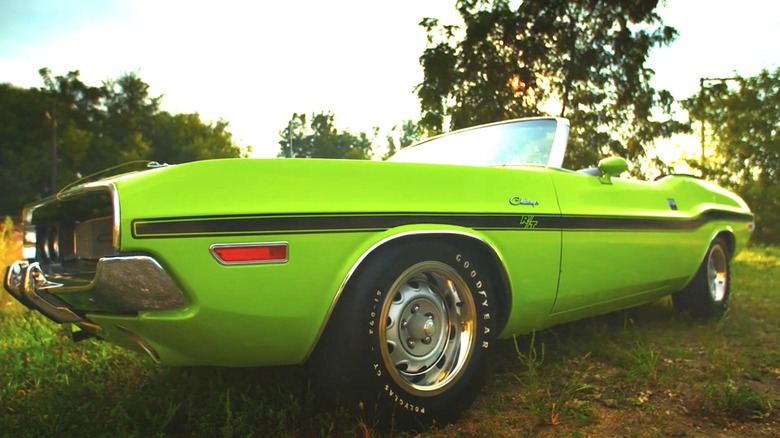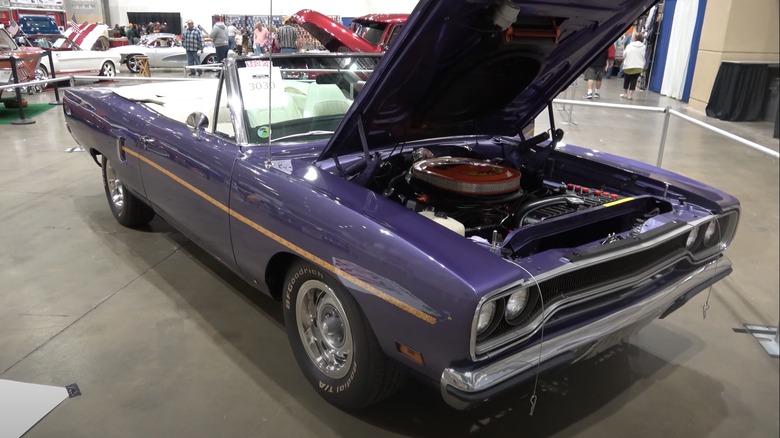5 Of The Rarest HEMI-Powered Muscle Cars Ever Built
In the muscle car arena, few words carry quite as much weight as Hemi. That word is, of course, short for "hemispherical," and in the context of engines, it denotes an engine with a hemispherical combustion chamber. Though the engine's origins can be traced back to the early 1900s, the Hemi, as modern drivers have come to know it, resulted from the work of Chrysler's engineering team, who debuted their own hemispherical engine in 1951.
Known as much for their durability and reliability as their outstanding performance and power output, Hemis would become a staple of the American muscle car era in the 1960s and 1970s. Given the modern Hemi's Chrysler roots, it should hardly come as a surprise that the engines could be found powering some of the most legit muscle cars of the era, particularly vehicles made by brands associated with the American auto manufacturer, such as Dodge and Plymouth.
Indeed, at the height of the muscle car madness, Hemis could be found powering some legit classics from the era like the Dodge Charger and the Plymouth Barracuda (aka the 'Cuda). Those engines were not standard, however, with the manufacturers typically offering them only as an under-the-hood upgrade for horsepower-hungry drivers. Given that fact, certain builds from those brands with Hemi engines can actually be pretty hard to find on the resale market. Here's a look at some of the rarest Hemi-powered vehicles ever built.
1969 Dodge Charger Daytona
The Dodge Charger undoubtedly ranks among the most celebrated muscle cars to ever hit the roadways. That was true almost from the moment the build debuted in 1966, with drivers falling head over heels for the vehicle's unforgettable mix of raw power and tough style. However, in 1969, Dodge's design team took the Charger's style to next-level territory when it debuted the flashy, and way ahead of its time Daytona build.
The Charger Daytona was tabbed as the successor to the Dodge Charger 500, which had unexpectedly failed to set the NASCAR circuit ablaze the year before. Hoping to transform the Charger into a track-chewing beast, Dodge outfitted its beloved muscle build with a wedged nose and an almost comically large rear spoiler that made it stand out from any Dodge that came before or, arguably, after. Yes, they also outfit the vehicle with a 426 Hemi V-8. The design upgrade proved successful and then some, with the Hemi-powered Daytona becoming the first vehicle to top 200 mph on the track.
While the Daytona was clearly not designed with everyday drivers in mind, it turns out that stock car rules deemed the manufacturer had to offer it for sale to the general public to qualify it for competition on the NASCAR circuit. In the end, Dodge complied with that rule, and manufactured an estimated 70 Daytona Chargers for public sale in 1969. Per Hagerty, a '69 Daytona in good condition could be worth more than $500,000 at auction, with Top Speed estimating one could fetch closer to $2 million.
1967 Dodge Coronet W023
When people talk about Dodge muscle cars, names like Charger and Challenger tend to dominate the rap. But in the early days of the muscle car movement, the Dodge Coronet — a primo restoration-ready ride these days – was one of the manufacturer's most powerful builds. And yes, in the mid-to-late 1960s, the build was offered with a Hemi engine under the hood.
The vehicle made its Dodge lineup debut in 1965 and did so with no particular shortage of power, with the manufacturer offering V8 power in both the two-door and four-door models. However, two years later, Dodge would deliver on its promise to outfit some of their factory builds with Hemi engines, and the '67 Coronet was one of the first benefactors of that move, getting a power upgrade in the guise of a 426 Street Hemi. Essentially factory-prepared race cars, the WO23 Coronets were notoriously stripped down (even in showroom models) to help bolster their speed credentials, and like the Charger Daytona, were designed and sold to the public in part so the build could qualify for legit track duty.
For those reasons, Coronets are revered among muscle car enthusiasts, including everyone's favorite funnyman gearhead Jay Leno. It's safe to assume the scarcity of WO23s is a big part of the '67 model's popularity, as it seems that Dodge only dropped Hemi engines into 55 Coronets in that model year. The raw power of those vehicles is almost legendary, with some hp estimates clocking it at 425 on the low side.
1970 Dodge Super Bee
On the subject of Dodge muscle cars too often relegated to secondary status, say hello to the Super Bee. Unlike some other glanced-over Dodge muscle cars, the Super Bee is sometimes forgotten because it was only a part of the manufacturer's factory lineup for a few years, with its production run lasting from 1968 to 1971.
As the story goes, Dodge developed the Super Bee to compete with Plymouth's road-burning Road Runner. Yes, the latter build from Plymouth also benefited from some good old Hemi power. While the Road Runner may be the more talked about of the two models, some would argue Dodge's Super Bee more than gave it a run for its money. Fittingly, the Super Bee's design reportedly took inspiration from the Coronet, doing so with a few Mopar B-body platform flourishes and boasting even fewer amenities than its predecessor.
As Super Bee devotees know, most models that hit the street between '68 and '71 did so with Dodge's 440ci Six-Pack V-8 pushing the ponies. Like most Dodge muscle cars of the day, Super Bees were also available with the 426 Hemi V8. However, it seems that by the time the 1970 model hit the streets, Super Bee super fans were largely opting for the Six Pack over the Hemi. Apparently, the Super Bee itself wasn't exactly selling like mad that year either, with Dodge reportedly making only about 36 of the vehicles with Hemi power in 1970. Just FYI — if you've got one to sell, it could be worth as much as $171,000, depending on its condition.
1970 Dodge Challenger R/T Convertible
It is pretty much impossible to talk about classic Hemi-powered Dodges from the muscle car era without talking about the Charger and the Challenger models. As we've already covered a super rare, Hemi-powered Charger, it's only fitting that we now turn our attention to an even rarer build, the 1970 Dodge Hemi Challenger R/T convertible.
The Challenger, of course, debuted in the Dodge lineup in 1970, with the manufacturer looking to fill out a muscle car sector that already included the Charger and the Super Bee. In terms of sheer power, the Challenger was more than capable of hanging with its Dodge siblings, with base models boasting 318ci, 340ci, or two-barrel 383ci power under the hood, and they were indeed available with a 426 Hemi V8 upgrade. As it happens, Hemi-powered Challengers are pretty rare in and of themselves, as it's estimated Dodge sold just over 200 in 1970.
It seems Challengers with a Hemi and the R/T trim package are even rarer, as it's estimated that Dodge manufactured only 60 such vehicle's in the build's first year of production. Most of those were of the hardtop persuasion, making convertible R/T Challengers with Hemi engines a rarity among the rare, as it's believed only 9 of them were made in 1970. As you can imagine, such scarcity has made them beyond sought after on the vintage car market, with Hagerty estimating a Hemi-powered convertible Challenger R/T in good condition is worth nearly $750,000. In an auction setting, that number could easily top $1 million, depending on the vehicle's condition.
1970 Plymouth Road Runner Convertible
That brings us to what may be the single rarest Hemi-powered muscle car in existence, the 1970 Plymouth Road Runner convertible. Yes, Plymouth's beastly muscle car actually borrowed its name from the iconic cartoon about a super speedy Road Runner dodging incessant and hilariously intricate attacks from one seriously wily coyote. And yes, the car's horn famously mimicked the "beep-beep" frequently uttered by the cartoon Road Runner. But when it came to style and raw power, there was nothing funny about the Plymouth Road Runner.
The vehicle arrived in the 1968 model year boasting some serious muscle under the hood and immediately became a best seller for Plymouth — who apparently moved more than 40,000 units that first year and more than 80,000 in 1969. Though sales dropped off in 1970, the vehicle was as powerful as ever, with stock models fronting the 335 horsepower 383 engine and the chance to upgrade to the 390 hp 440 Six-Pack or the more expensive 425 hp 426 Hemi V-8 available.
However, just like the Dodge Challenger, the bulk of Road Runners sold in 1970 were hard-topped, with many buyers also opting for the Six-Pack engine over the Hem. Even Six-Pack Road Runners are rare, with Plymouth manufacturing a reported 34 convertibles with that engine. Hemi-powered Road Runner convertibles, on the other hand, are pretty much non-existent, as it's believed Plymouth made only 3 in 1970. Rumor has it that one of those even came with a four-speed transmission and Plymouth's famed pistol grip shifter, making it a true one-of-one rarity.
